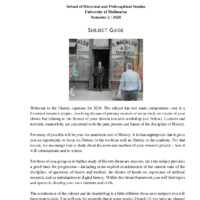Item
HIST30060: Food Relief Centre Queue
Title (Dublin Core)
HIST30060: Food Relief Centre Queue
Disclaimer (Dublin Core)
DISCLAIMER: This item may have been submitted in response to a school assignment prompt. See Linked Data.
Description (Dublin Core)
This is a photograph taken of a queue to enter a food relief centre in South Melbourne in August 2020. The queue was several hundred metres long.
As lockdowns began to ravage Melbourne, most businesses were forced to close, resulting in many people losing their jobs. Where this food relief centre had services around 100 people at the start of 2020, this number swelled to over 2000 by the height of the pandemic.
Among the most vulnerable demographics affected by the pandemic restrictions were international casual workers and students. Where citizens were eligible to apply for various emergency relief payments, such as Job Keeper or Job Seeker, migrants did not have access to these resources. This food bank only required a form of identification to register the recipients.
Several pandemic related restrictions are shown in this picture. The recipients are socially distanced, standing on makeshift markings spaced 1.5 metres apart by government restriction. They wear masks; a government requirement both indoors and outdoors at the height of the pandemic in Victoria. The food bank volunteers wear neon orange high-visibility vests and hold QR codes for the recipients to register on their own devices. I have volunteered at the food relief centre since 2020, performing the same role as the volunteers in the photograph.
Where mainstream historical narratives and media may focus on how the lockdowns affected citizens, it is important to remember how migrants too were affected by the pandemic and had little to know support from the Australian government.
As lockdowns began to ravage Melbourne, most businesses were forced to close, resulting in many people losing their jobs. Where this food relief centre had services around 100 people at the start of 2020, this number swelled to over 2000 by the height of the pandemic.
Among the most vulnerable demographics affected by the pandemic restrictions were international casual workers and students. Where citizens were eligible to apply for various emergency relief payments, such as Job Keeper or Job Seeker, migrants did not have access to these resources. This food bank only required a form of identification to register the recipients.
Several pandemic related restrictions are shown in this picture. The recipients are socially distanced, standing on makeshift markings spaced 1.5 metres apart by government restriction. They wear masks; a government requirement both indoors and outdoors at the height of the pandemic in Victoria. The food bank volunteers wear neon orange high-visibility vests and hold QR codes for the recipients to register on their own devices. I have volunteered at the food relief centre since 2020, performing the same role as the volunteers in the photograph.
Where mainstream historical narratives and media may focus on how the lockdowns affected citizens, it is important to remember how migrants too were affected by the pandemic and had little to know support from the Australian government.
Date (Dublin Core)
August 7, 2020
Creator (Dublin Core)
Margaret Chambers
Contributor (Dublin Core)
self
Event Identifier (Dublin Core)
HIST30060
Partner (Dublin Core)
University of Melbourne
Type (Dublin Core)
Photograph
text
Controlled Vocabulary (Dublin Core)
English
Community Service
English
Social Distance
English
Community & Community Organizations
Curator's Tags (Omeka Classic)
Australia
food bank
waiting
migrants
students
workers
volunteering
restrictions
Contributor's Tags (a true folksonomy) (Friend of a Friend)
Food Relief Centre
Foodbank
Emergency Relief
Charity
Volunteers
Migrants
Students
Citizens
Pandemic response
Melbourne
Australia
Compassion
Linked Data (Dublin Core)
Date Submitted (Dublin Core)
10/26/2022
Date Modified (Dublin Core)
10/29/2022
11/01/2022
11/02/2022
Date Created (Dublin Core)
08/07/2020
Item sets
This item was submitted on October 26, 2022 by Margaret Chambers using the form “Share Your Story” on the site “A Journal of the Plague Year”: http://mail.covid-19archive.org/s/archive
Click here to view the collected data.

